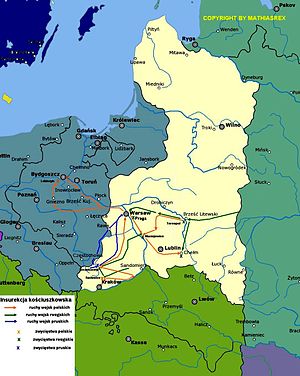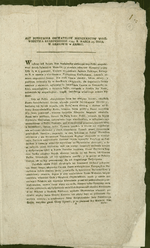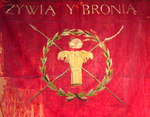Kościuszko Uprising






The Kościuszko Uprising was an uprising against Imperial Russia and the Kingdom of Prussia[1] led by Tadeusz Kościuszko in Poland, Belarus and Lithuania in 1794. It was a failed attempt to liberate Poland and Lithuania from Russian influence after the Second Partition of Poland (1793) and the creation of the Targowica Confederation.
Background
The first partition of Poland and the war in the defence of constitution seriously weakened the reformist movement in the Crown territory of Poland and the Grand Duchy of Lithuania, supporting the May Constitution. However, after the second partition of Poland, the ruling partisans of Imperial Russia united in the Confederation of Targowica were also weakened. The people supporting Russia as the main guarantor of the golden freedoms after the second partition were seen as traitors to their country rather than heroes and opposition to their rule gained much support, both within the nobility and the burghers.
To suppress the opposition, the governments of Prussia and Russia agreed to demobilise 50% of the Polish Army and draft the remaining Polish soldiers into their own armies. On 12 March 1794, General Antoni Madaliński, the commander of 1st Greater Polish National Cavalry Brigade (1,500 men) decided to disobey the order to demobilise, advancing his troops from Ostrołęka to Kraków. This sparked an outbreak of riots against Russian forces throughout the country. The Russian garrison of Kraków was ordered to leave the city and defeat the Polish forces. This left the city completely undefended.
Uprising
On 24 March 1794, Tadeusz Kościuszko, a veteran of the American Revolutionary War, announced the general uprising and assumed the powers of the Commander in Chief of all of the Polish forces. He also vowed
- not to use these powers to oppress any person, but to defend the integrity of the borders of Poland, regain the independence of the nation, and to strengthen universal liberties.

In order to strengthen the Polish forces, Kościuszko issued an act of mobilisation, requiring that every 5 houses in Lesser Poland delegate at least one able male soldier equipped with carbine, pike, or an axe. Kościuszko's staff estimated that by mobilising all able males between 18 and 40 years of age the army of the uprising would soon reach 10,000. The difficulties with providing enough armament for the mobilised troops made Kościuszko form large units composed of people armed with scythes.
To destroy the still weak opposition, Russian Empress Catherine the Great ordered the corps of Major General Fiodor Denisov to attack Kraków. On 4 April both armies met near the village of Racławice. In what became known as the Battle of Racławice Kościuszko's forces defeated the numerically and technically superior opponent. After the bloody battle the Russian forces withdrew from the battlefield. Kościuszko's forces were too weak to start a successful pursuit and wipe the Russian forces out of Lesser Poland. Although the strategic importance of the victory was close to none, the news of the victory spread fast and soon other parts of Poland joined the ranks of the revolutionaries. By early April the Polish forces concentrated in the lands of Lublin and Volhynia, ready to be sent to Russia, joined the ranks of Kościuszko's forces.
On 17 April in Warsaw, the Russian attempt to arrest those suspected of supporting the insurrection[2] and to disarm the weak Polish garrison of Warsaw under Gen. Stanisław Mokronowski by seizing the arsenal at Miodowa Street[3] resulted in an uprising against the Russian garrison of Warsaw, led by Jan Kiliński, in the face of indecisiveness of the King of Poland, Stanisław II Augustus. The insurgents were aided by the incompetence of Russian ambassador and commander, Iosif Igelström, and the fact that the chosen day was the Thursday of Holy Week when many soldiers of the Russian garrison went to the churches for the Eucharist not carrying their arms. Finally, from the onset of the insurrection, the Polish forces were aided by the civilian population and had surprise on their side as they attacked many separate groups of soldiers at the same time and the resistance to Russian forces quickly spread over the city. After two days of heavy fighting the Russians, who suffered between 2,000 to 4,000 casualties out of an initial 6,000 strong garrison, were forced to leave the city. A similar uprising was started by Jokūbas Jasinskis in Vilnius on 22 April and soon other cities and towns followed. The massacre of unarmed Russian soldiers attending the Easter service was regarded as a "crime against humanity" by Russians and was an argument for a vengeance later, during siege of Warsaw.[citation needed]
On 7 May 1794, Kościuszko issued an act that became known as the "Proclamation of Połaniec", in which he partially abolished the serfdom in Poland, granted civil liberty to all peasants and provided them with state help against the abuses by the nobility. Although the new law never fully came into being and was boycotted by much of the nobility, it also attracted many peasants to the ranks of the revolutionists. It was the first time in Polish history when the peasants were officially regarded as part of the nation, the word being previously equal to nobility.

Despite the promise of reforms and quick recruitment of new forces, the strategic situation of the Polish forces was still critical. On 10 May the forces of Prussia crossed the Polish borders and joined the Russian armies operating in northern Poland. On 6 June Kościuszko was defeated in the Battle of Szczekociny by a joint Russo-Prussian force and on 8 June General Józef Zajączek was defeated in the Battle of Chełm. Polish forces withdrew towards Warsaw and started to fortify the city. On 15 June the Prussian army captured Kraków unopposed, but the Russian forces were defeated in a series of skirmishes near Warsaw and the defenders managed to finish the fortification efforts. Although it was besieged by Russo-Prussian forces on 22 July, the siege was unsuccessful. On 20 August, an uprising in Greater Poland started and the Prussians were forced to withdraw their forces from Warsaw. The siege was lifted soon afterwards, on 5 September. Russian forces commanded by Ivan Fersen were withdrawn towards Pilica River.


Although the opposition in Lithuania was crushed by Russian forces (Vilnius was besieged and capitulated on 12 August), the uprising in Greater Poland achieved some success. A Polish corps under Jan Henryk Dąbrowski captured Bydgoszcz (2 October) and entered Pomerania almost unopposed. Thanks to the mobility of his forces, General Dąbrowski evaded being encircled by a much less mobile Prussian army and disrupted the Prussian lines, forcing the Prussians to withdraw most of their forces from central Poland.
Meanwhile, the Russians equipped a new corps commanded by General Aleksandr Suvorov and ordered it to join up with the corps under Ivan Fersen near Warsaw. After the battles of Krupczyce (17 September) and Terespol (19 September), the new army started its march towards the Polish capital. To prevent both Russian armies from joining up, Kościuszko mobilised his forces in Warsaw and on 10 October started the Battle of Maciejowice. Despite Kościuszko's plans, both Russian units entered the combat simultaneously and won the battle. Kościuszko himself was wounded in the battle and was captured by the Russians, who sent him to Saint Petersburg.
The new commander of the uprising, Tomasz Wawrzecki, was not able to control the spreading internal struggles for power and ultimately became only the commander of weakened military forces, while the political power was held by General Józef Zajączek, who in turn had to struggle with both the leftist liberal Polish Jacobins and the rightist and monarchical nobility.
On 4 November the joint Russian forces started an all-out assault on Praga, the right-bank suburb of Warsaw. After 4 hours of long hand-to-hand struggle, the 24,000 men strong Russian forces broke through the Polish defences and started to loot and burn the borough. The whole district was completely destroyed and approximately 20,000 of its inhabitants were murdered. The event became known as the massacre of Praga. Dispirited Wawrzecki decided to withdraw his remaining forces southwards and on 5 November Warsaw was captured.
On 16 November, near Radoszyce, Wawrzecki surrendered. This marked the end of the uprising. The power of Poland was broken and the following year the third partition of Poland happened, after which Austria, Russia and Prussia annexed the remainder of the country.
Aftermath
After the failure of the Kościuszko Uprising, the country ceased to exist for 123 years and all of its institutions were gradually banned by the partitioning powers. However, the uprising also marked the start of modern political thought in Poland and Central Europe. Kościuszko's Proclamation of Połaniec and the radical leftist Jacobins started the Polish leftist movement. Many prominent Polish politicians who were active during the uprising became the backbone of Polish politics, both home and abroad, in the 19th century. Also, Prussia had much of its forces tied up in Poland and could not field enough forces to suppress the French Revolution, which added to its success.
In the lands of partitioned Poland, the failure of the uprising meant economic catastrophe, as centuries-old economic markets became divided and separated from each other, resulting in the collapse of trade. Several banks fell and some of the few manufacturing centres established in the Commonwealth were closed. Reforms made by the reformers and Kosciuszko, aimed at easing serfdom, were revoked. All the partitioning powers heavily taxed their newly-acquired lands, filling their treasuries at the expense of the local population.
The schooling system was also degraded as the schools in those territories were given low priority. The Commission of National Education, the world's first Ministry of Education, was abolished, because the absolutist governments of the partitioning powers saw no gain in investing in education in the territories inhabited by restless Polish minorities. The creation of educational institutions in the partitions became very difficult. For example, an attempt to create a university in Warsaw was opposed by the Prussian authorities. Further, in the German and Russian partitions, all remaining centres of learning were subject to Germanisation and Russification; only in territories acquired by Austria was there relatively little governmental intervention in the curriculum.[4] According to S. I. Nikołajew, from the cultural point of view the partitions may have given a step forward towards the development of national Polish literature and arts, since the inhabitants of partitioned lands could acquire the cultural developments of German and Russian Enlightenment.[5]
The conditions for the former Polish elite were particularly harsh in Russian partition. Thousands of Polish schlachta families who supported Kościuszo's uprising were stripped of their possessions and estates, which were in turn awarded to Russian generals and favourites of the Petersburg court. It is estimated that 650,000 former Polish serfs were transferred to Russian officials in this manner.[4] Some among the nobility, especially in Lithuanian and Ruthenian regions of the former Commonwealth, were expelled to southern Russia, where they were subject to Russification. Other nobles were denied their nobility status by Russian authorities, which meant loss of legal privileges and social status, significantly limiting any possibility of a career in administration or the military - the traditional career paths of Polish nobles. It also meant that they could not own any land, another blow to their former noble status. But for Orthodox Christian peasants of Western Ukraine and Belarus, the partition may have brought the decline of religious oppression by their formal lords, followers of Roman Catholicism.[6]
However, Orthodox Christians were only a small minority in Eastern Belarus at that time; the prevailing majority of the country's population was Eastern rite Catholics. Peasants were flogged just for mentioning the name of Kościuszko and his ideas of abolishing serfdom. Platon Zubov, who was awarded estates in Lithuania, was especially infamous, as he personally tortured to death many peasants who complained about worsening conditions. Besides this, the Russian authorities conducted heavy recruiting for the Russian army among the population, which meant a practically lifelong service.[4] Since the conditions of serfdom in former Poland due to the exploitation by nobility and arendators were already severe, discussion exists on how partitions influenced the life of common people.[7]
See also
References
- Inline
- ^ Bartłomiej Szyndler. Powstanie kościuszkowskie (in Polish) (1994 ed.). Wydawn. Ancher. p. 455. ISBN 838557610X.
- ^ Henry Smith Williams, The Historians' History of the World, The Outlook Company, 1904, Google Print, p.418
- ^ Grzegorz Reszka (2005). "Insurekcja kościuszkowska". polskiedzieje.pl. Retrieved 29 March 2006.
- ^ a b c Anna Radziwił, Wojciech Roszkowski, Historia 1789-1871 Warsaw 2000
- ^ Nikołajew, S. I. Od Kochanowskiego do Mickiewicza. Szkice z historii polsko-rosyjskich związków literackich XVII–XIX wieku / Tłum. J. Głażewski. Warszawa: Neriton, 2007. 319 s. (Nauka o Literaturze Polskiej za Granicą, t. X)
- ^ Kalik, Judith. The Orthodox Church and the Jews in the Polish-Lithuanian Commonwealth. Jewish history, Volume 17, Number 2. May 2003. P. 229-237
- ^ Kula, Witold. An Economic Theory of the Feudal System: Towards a Model of the Polish Economy, 1500–1800. Translated by Lawrence Garner. New ed. London, 1976.




